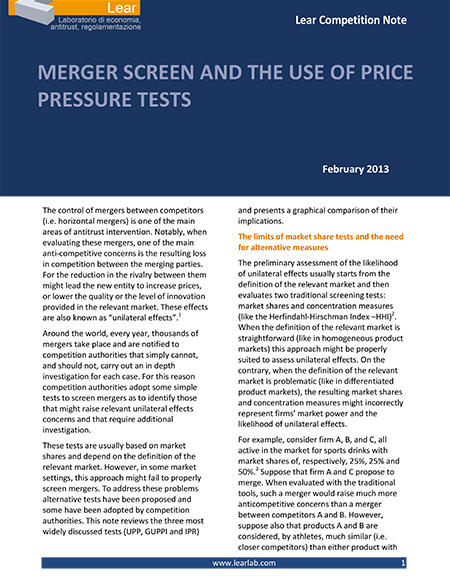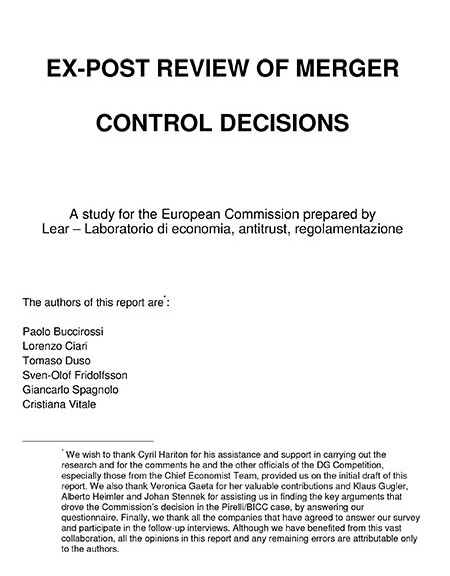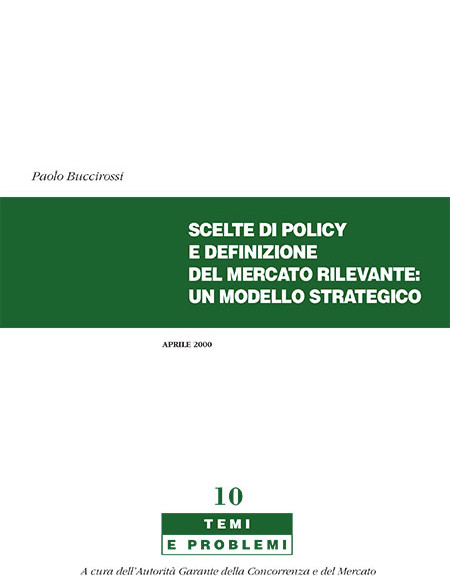Mergers between competitors might generate relevant anti-competitive effects. Therefore, competition authorities need effective tests to make a preliminary assessment of the likelihood of unilateral effects of horizontal mergers. These tests are usually based on market shares and rely on the definition of the relevant market. However, in some market settings, this approach might fail to screen mergers adequately. To overcome the limitation of traditional tools some alternative tests have been proposed. This note reviews the Upward Pricing Pressure (UPP), the Gross Upward Pricing Pressure Index (GUPPI) and the Illustrative Price Rise (IPR) and presents a graphical comparison of their implications.
Archives
Ex post review of merger control decisions
In this study prepared for the European Commission Lear proposes a methodology for the ex-post assessment of merger control decisions. The aim of the methodology is to establish whether the market structure arising from the decision protects social welfare better than the market structures that could have arisen from alternative decisions. The methodology also assesses whether the underlying economic analysis is correct and complete. The study then applies the proposed approach to the EU decision on the Pirelli and BICC merger.
Published by the European Commission (February 2007)
Competition in the Internet Backbone Market
This paper presents a competitive assessment of the global market for the provision of universal Internet connectivity (backbone market). We discuss the approach followed by the EC Commission in two important merger cases. The main argument is for a restless evolution of the structure of the market, whereby an highly concentrated US-centric industry, with a strict vertical hierarchy between Internet Service Providers and a neat separation between first-level ISPs and the rest of the market, is going to be superseded by a more horizontally shaped configuration. It is argued that, as the landscape of the industry is subject to continuous change, the approach followed by the EC Commission in assessing the competitive forces that drive the industry is likely to be no longer appropriate. New behavioral strategies, such as differentiation through the introduction of new enhanced Internet services based on the concept of Quality of Service, and, related to that, new competitive threats seem to characterize the foreseeable future of the Internet. We then investigate the competitive concerns that might emerge in the new environment.
A Search Model Where Consumers Choose Quantity Based on Expected Price
I describe a price game in which consumers face search costs and base their quantity decision on the expected price. Because of search costs, the choice of the firm they will buy from is described by a random process. I show that the expected equilibrium price is above the monopoly price. This result does not change if demand comes from a small share of perfectly informed consumers with zero search costs.
Published in The Journal of Industrial Economics, December 2003, Vol. LI, n. 4, pp. 427-32.
Competition Policy and the Agribusiness Sector in the European Union
This paper analyses the main antitrust decisions in the agribusiness sector in Europe. First, legislation and economic principles are recalled. Then for input suppliers, farmers, manufacturers, and retailers, we give a brief presentation of the market structure and discuss the main competition concerns according to the most recent antitrust decisions. Farmers are the weakest link of the entire chain, given the degree of concentration in the upstream and downstream industries in Europe. The use of the concept of buying power could be developed by competition authorities to balance power along the agro-food chain.
Published in European Review of Agricultural Economics, 29(3), August 2002, pp. 373-397.
Scelte di policy e definizione del mercato rilevante: un modello strategico
Published by the Italian Competition Authority in its series Temi e problemi n. 10
Access to an Essential Facility: Efficient Component Pricing Rule or Unrestricted Private Property Rights
In this paper we compare the access to an essential facility in two different property rights regimes. In one of them, the owner of the facility has a full private property right. In the other, access is regulated according to the efficient component pricing rule. Proponents of the second regime claim that this rule is efficient, for it forecloses the complementary market only to inefficient producers. We prove that the two legal frameworks are equivalent if we do not consider the possibility of the transfer of the property right and that if this is allowed the efficient component pricing rule might exclude efficient suppliers.




